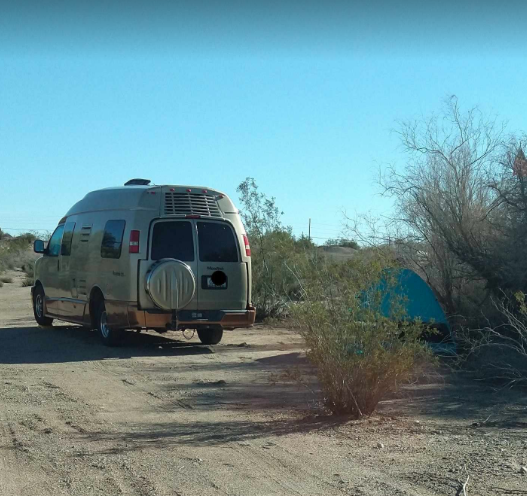In former years we often went on day trips exploring the are. One of the interesting parts is the
Colorado River around Yuma, AZ. Long time ago, while the river had lots of water, it was a major transport way for settlers, gold miners and goods. Big steam ships came all the way to Yuma, which is hard to imagine when one sees how low the river is nowadays. After the railroad was built the river got less used for transport.
 |
| Workers in the fields |
Later the Imperial Dam Project created a lot dams, lakes and canals and the water was used more and more for agriculture irrigation.
Nowadays the dams and small lakes are also used for recreational purposes like camping, boating, fishing, water skiing and bird watching.
An interssant article is this one “ History of Fisher’s Landing”.
We decided to check out "Martinez Lake" and the "Imperial Wildlife Refuge".
On our way to the destination
we drove through "Yuma Proving Grounds",
a military training site.
Today they observed parachuters.
Martinez Lake, which was booming in the 50ies and 60ies seemed to be dead on our visit.
Only 90 year round residents live there nowadays (census 2020), down from nearly 800 according to the census of 2010.
The properties vary between modern Adobe style houses/condos and many dilapidated RVs , lots of run down trailers and old trailer homes.
The restaurant/resort/bar area was deserted, as was the boat moorings.
Maybe it was because it is off season? During winter month the Colorado River and surrounding lakes are at its lowest, exacerbated by decades of drought.
The banks of the lake and wetlands were heavily invaded by non-native Common Reeds (Phragmites).
The whole looked more like a big puddle than a lake.
 |
| Overgrown part of the wetlands and river side arms |
A view of the river was no-where to be seen.
But the old mining area around the Information Centre was interesting to visit.
The sands and soil that the ancient Colorado River had moved around after the ice age showed a lot of different colours and forms. Wulfenite, a molybdenum mineral can still be mined nearby.
 |
| Anna's Hummingbird |
A few birds showed up while we had lunch at the Visitors Centre.
 |
| Northern Mockingbird (Spottdrossel) |
 |
| Desert Tortoise (Wüstenschildkröte) |
Translation for my German readers
In früheren Jahren sind wir oft auf Erkundungsfahrten gegangen. Eine der interessanten Gegenden ist der Colorado River um die Stadt Yuma, AZ herum.
Im frühen 19ten Jahrhundert, als der Fluß noch viel Wasser führte, war er die Haupttransportader. Große Raddampfer brachten Siedler, Goldgräber und Waren hierher. As später die Eisenbahn gebaut wurde wurde der Fluß weniger zum Transport genutzt. Man leitete das Wasser in Bewässerunggräben zu den sich ausdehnenden Landwirtschaftsflächen. Das "Imperial Dam Projekt" baute Dämme und staute das Wasser in Seen und leitete es Kanälen zu den Feldern. Heutzutage wird die Gegend zusätzlich als Naherholungsgebiet für die Bewohner von Yuma benutzt.
Camping, Angeln, Wassersport und die Natur der Umgebung laden dazu ein.
Wir wollten die Umgebung von “Martinez Lake” und das umliegende Naturschutzgebiet erkunden.
Auf unserem Weg zum Ziel durchquerten wir dabei das Militärübungsgelände von Yuma. Einige Fallschirmspringer waren im Training.
Marinez Lake war in den 50iger und 60ier Jahren sehr populär. Auf unserem Besuch sah es eher ausgestorben aus. Nur 90 Bewohner (Volkszählung 2020) leben hier das ganz Jahr über. Im Jahre 2010 waren es noch fast 800. Die Bebauung war chaotisch. Moderne Adobe Häuser und viele alte Wohntrailer existieren dicht nebeneinander. Das Restaurant/Bar/Resort war geschlossen und die Bootsstege verlassen.
Vielleicht lag es an der Jahreszeit. Im Winter hat der Colorado River seinen niedrigsten Wasserstand, dazu kommt noch die Jahrelange Dürre die hier herrscht.
Die Ufer um den See und die Feuchtgebiete sind von eingeführten, standortfremden Reedgräsern und Schilf völlig überwuchert. Von dem See ist kaum noch etwas übrig.
Doch die Gegend um das Besucherzentrum war interessant. Das Colorado Rive Schwemmgebiet hat viele Minen beherbergt. Auch heute kann man dort noch Wulfenite finden.
Beim Picnic hinter dem Besucherzentrum fanden wir das Gehege von drei Wüstenschildkröten.






































